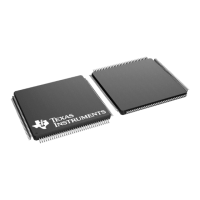Analog-to-Digital Converter (ADC)
6 - 8 TMS320F2837xD Microcontroller Workshop - Analog Subsystem
The ADC ping-pong triggering example in the figure above shows channels B0 through B5 being
converted, triggered initially by software. After channel B2 is converted, ADCINT1 is generated,
which also triggers channel B3. After channel B5 is converted, ADCINT2 is generated and is also
fed back to start the process again from the beginning. Additionally, ADCINT1 and ADCINT2 are
being used to manage the ping-pong interrupts for the interrupt service routines.
ADC Conversion Priority
ADC Conversion Priority
When multiple SOC flags are set at the same time –
priority determines the order in which they are converted
High Priority
High priority SOC will interrupt the round robin wheel
after current conversion completes and insert itself as
the next conversion
After its conversion completes, the round robin wheel
will continue where it was interrupted
Round Robin Burst Mode
Allows a single trigger to convert one or more SOCs in
the round robin wheel
Uses BURSTTRIG instead of TRIGSEL for all round
robin SOCs (not high priority)
Round Robin Priority (default)
No SOC has an inherent higher priority than another
Priority depends on the round robin pointer
When multiple triggers are received at the same time, the ADC conversion priority determines the
order in which they are converted. Three different priority modes are supported. The default
priority mode is round robin, where no start-of-conversion has an inherently higher priority over
another, and the priority depends upon a round robin pointer. The round robin pointer operates in
a circular fashion, constantly wrapping around to the beginning. In high priority mode, one or
more than one start-of-conversion is assigned as high priority. The high priority start-of-
conversion can then interrupt the round robin wheel, and after it has been converted the wheel
will continue where it was interrupted. High priority mode is assigned first to the lower number
start-of-conversion and then in increasing numerical order. If two high priority start-of-conversion
triggers occur at the same time, the lower number will take precedence. Burst mode allows a
single trigger to convert one or more than one start-of-conversion sequentially at a time. This
mode uses a separate Burst Control register to select the burst size and trigger source.

